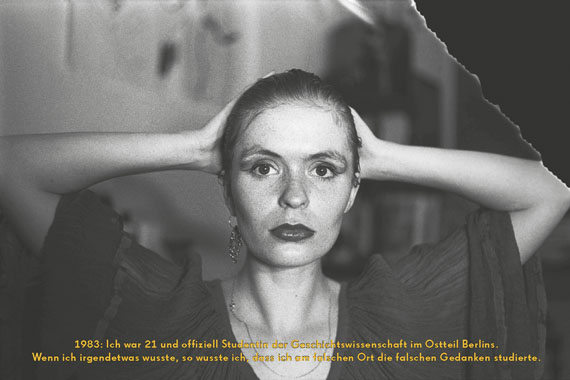
If I knew anything at all, I knew that I was in the wrong place being taught the wrong mindset.
ina Bara, Lange Weile (Boredom/A Long Time), 2016
Courtesy the artist
© Tina Bara
From Far Away. Images of the GDR
Von Ferne. Bilder zur DDR
Tina Bara » Seiichi Furuya » Tamami Iinuma » Sven Johne » Jens Klein » Jürgen Kuttner » Christian Lange » Emanuel Mathias » Katrin Mayer » Simon Menner » Einar Schleef » Christine Schlegel » Joachim Schmid » Erasmus Schröter » Maya Schweizer » Gabriele Stötzer » Paul Alexander Stolle » Elisabeth Tonnard » Andreas Trogisch » Ulrich Wüst » Joerg Waehner » & others
Exhibition: 6 Jun – 15 Sep 2019
Wed 5 Jun 19:00
Museum Villa Stuck
Prinzregentenstr. 60
81675 München
Tue-Sun 11-18
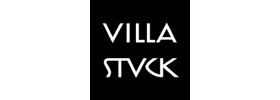
Museum Villa Stuck Interim
Goethestraße 54
München
089-4555510
villastuck@muenchen.de
www.villastuck.de
Tue-Sun 12-20
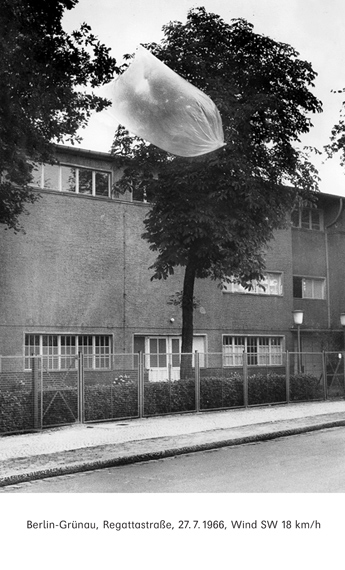
Courtesy the artist
Photo: © Archiv der BstU
"From Far Away. Images of the GDR"
With works by Tina Bara, Seiichi Furuya, Tamami Iinuma, Sven Johne, Jens Klein, Jürgen Kuttner, Christian Lange, Emanuel Mathias, Katrin Mayer, Simon Menner, Einar Schleef, Christine Schlegel, Joachim Schmid, Erasmus Schröter, Maya Schweizer, Gabriele Stötzer, Paul Alexander Stolle, Elisabeth Tonnard, Andreas Trogisch, Joerg Waehner, and Ulrich Wüst.
Exhibition: 6 June – 15 September, 2019
Opening: Wednesday, 5 June, 7pm
The group exhibition "From Far Away. Images of the GDR" features photographs from, and about, the GDR. The works on display are photographs by others and of their own (used again) that the artists have appropriated and rereleased for fresh viewing. Some of these works go beyond appropriation on the visual plane to interlock image and text in transmedial approaches, using one as the foil to the other and vice versa.
The strategies deployed for making appropriated pictures visible and legible enable a wide range of subjects to be touched on: be it a view of an artist’s own biography and, therefore, often his or her own photographic work (with biographical links); be it dealing with sought and found images, such as picture postcards made from genuine photos, or photographs from the State Security Service dossier archives, private archives, and GDR publications (books, promotional catalogues, newspapers). Detached from their original contexts, these pictures have been enlarged, reconfigured, transposed to other aesthetic and semantic contexts, and, finally, released for interpretation. Thus they generate questions about the spaces they once occupied and about their epistemic value: What do these pictures tell? Do they give answers? If so, to what questions?
All these pictures tell of places and situations as they once were. Nonetheless, the question arises of what reality a picture represents, especially when new, different relationships are created between images through artistic intervention. Dealing with the visual legacy of the GDR means not only revealing traces of reality going back to a time past: The exhibition is less concerned with the production of pictures and their potential for recording snippets from space and time than it is with the stores of knowledge they conceal and their multiple meanings. The specific contexts in which the photographs were taken and the times at which they were shot are visible, yet, most importantly, the question arises of how they are to be further dealt with and to which other semantic planes they have been, and are being, transported.
The eighteen artistic positions highlighted by the exhibition cover the years 1981 to 2019; films, readings, and performances supplement the show as temporary projects. There is also an accompanying bilingual catalogue, published by Verlag der Buchhandlung Walther König, Köln. Edited by Michael Buhrs and Sabine Schmid, it contains texts by Annett Gröschner, Vanessa Joan Müller, Sabine Schmid, and Christoph Tannert as well as texts and pictures by the artists themselves.
Curated by Dr. Sabine Schmid�
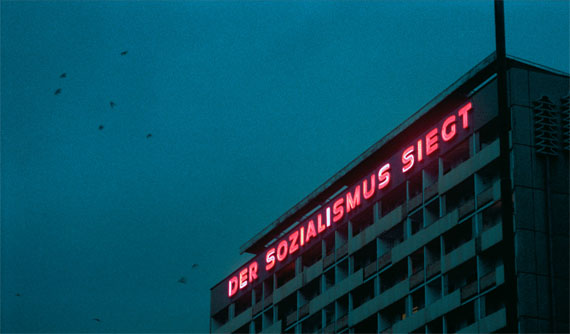
Seiichi Furuya, Mémoires, 2012
Courtesy Galerie Thomas Fischer
© Seiichi Furuya
"Von Ferne. Bilder zur DDR"
Mit Arbeiten von Tina Bara, Seiichi Furuya, Tamami Iinuma, Sven Johne, Jens Klein, Jürgen Kuttner, Christian Lange, Emanuel Mathias, Katrin Mayer, Simon Menner, Einar Schleef, Christine Schlegel, Joachim Schmid, Erasmus Schröter, Maya Schweizer, Gabriele Stötzer, Paul Alexander Stolle, Elisabeth Tonnard, Andreas Trogisch, Joerg Waehner und Ulrich Wüst.
Ausstellung: 6. Juni bis 15. September 2019
Eröffnung: Mittwoch, 5. Juni, 19 Uhr
Die Gruppenausstellung "Von Ferne. Bilder zur DDR" zeigt fotografische Bilder aus der und über die DDR. Zu sehen sind Arbeiten, für die sich Künstler*innen fremde wie auch eigene Bilder (erneut) aneignen und für eine Neubetrachtung öffnen. Manche Arbeiten gehen über die Aneignung auf visueller Ebene hinaus, verschränken in medienübergreifenden Ansätzen Bild und Text, verwenden das eine als Gegenstück des anderen und umgekehrt.
Mit den verschiedenen Strategien des Sichtbarmachens angeeigneter Bilder werden ganz unterschiedliche Themen berührt: sei es der Blick auf die eigene Biografie und oftmals auf das (damit verknüpfte) eigene fotografische Werk; sei es der Umgang mit gesuchten und gefundenen Bildern, so etwa Echt-Foto-Postkarten, Fotografien aus dem Stasi-Unterlagen-Archiv, aus privaten Archiven und aus Publikationen aus der DDR (bspw. Bücher, Werbekataloge, Zeitungen). Bilder werden aus ihrem ursprünglichen Zusammenhang herausgelöst; sie werden erweitert, rekonfiguriert, in andere ästhetische wie inhaltliche Kontexte übersetzt und letztlich zur Interpretation freigestellt. So eröffnen sie Fragen nach den Räumen, in denen sie einst standen und nach ihrem Erkenntniswert: Wovon erzählen die Bilder? Geben sie Antworten? Falls ja: auf welche Fragen?
Die Bilder in der Ausstellung erzählen allesamt von Orten und Situationen, wie sie einst existierten. Doch stellt sich die Frage, welche Wirklichkeit ein Bild repräsentiert, zumal wenn zwischen den Bildern durch den künstlerischen Eingriff andere und neue Beziehungen hergestellt werden. Im Umgang mit dem visuellen Nachlass der DDR wollen nicht nur Spuren von Wirklichkeit aufgezeigt werden, die einer vergangenen Zeit entstammen: In der Ausstellung geht es weniger um die Produktion von Bildern und ihr Potenzial, Ausschnitte aus Raum und Zeit zu fixieren, als vielmehr um verborgene Wissensvorräte und um ihre Vieldeutigkeit. Der spezifische Kontext und der Zeitpunkt, zu dem die Fotografien entstanden sind, sind sichtbar, doch es stellt sich vor allem die Frage nach dem weiteren Umgang mit ihnen und den weiteren Bedeutungsebenen, die in sie hineingetragen wurden und werden.
Die Ausstellung zeigt 18 künstlerische Positionen aus den Jahren 1981 bis 2019; Filme, Lesungen und Performances ergänzen als temporäre Projekte die Schau. Begleitend erscheint ein zweisprachiger Katalog im Verlag der Buchhandlung Walther König, Köln, herausgegeben von Michael Buhrs und Sabine Schmid mit Texten von Annett Gröschner, Vanessa Joan Mülller, Sabine Schmid und Christoph Tannert sowie mit Text- und Bildbeiträgen der Künstler*innen.
Kuratiert von Dr. Sabine Schmid�
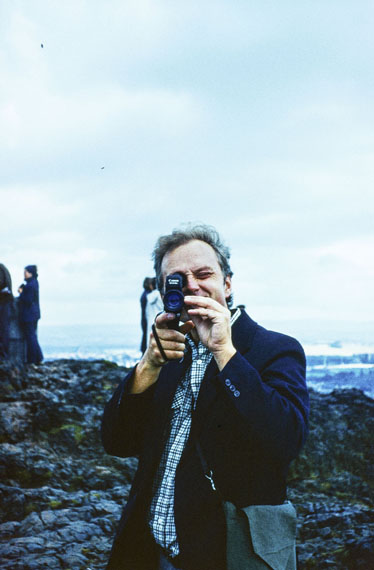
Courtesy the artist
Foto: © Heiner Stolle
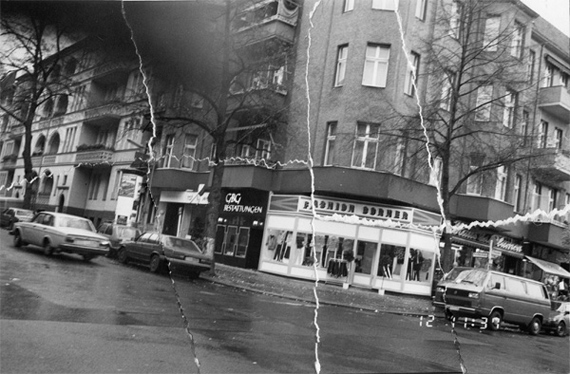
Zerstörte Bilder, im Rahmen des Projektes Bilder aus den geheimen Archiven der Staatssicherheit, 2010–2015, 2019
12 Fotografien, C-Prints, gerahmt
Courtesy the artist
Foto: © Simon Menner und BStU